Though our trip was brief, Audrey and I still made it our mission to see as many sights and attractions as possible around Athens. First, we set out to visit temples and ruins steeped in history, but along the way we also discovered that the Greek capital is a city with a pretty cool vibe, lots of art, and great food.

This city guide showcases 20 things to do in Athens, Greece in the form of a travel guide, video & photo essay:
20 Things to Do in Athens, Greece
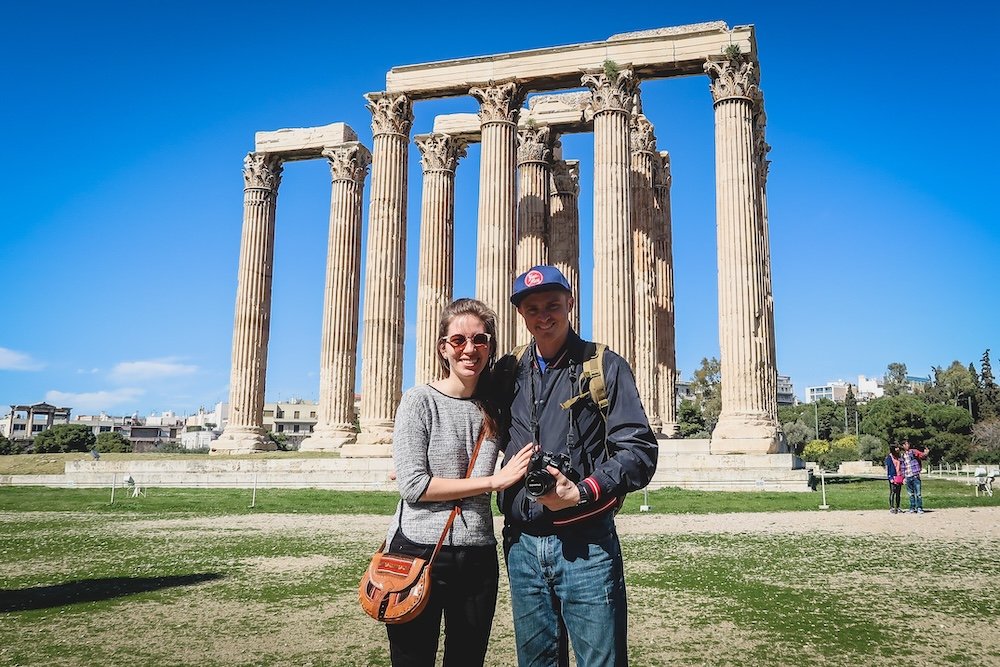
1) Parthenon
(Greek: Παρθενών – Παρθενώνας)
Our first stop was one of the most recognized sights in Athens – the Parthenon, which was dedicated to the goddess Athena who was seen as the patron of Athens.
Completed in 436 BC it is generally considered to be the most important remaining building of Classical Greece and a symbol of western civilization.
The Parthenon is a masterpiece of Doric architecture. Its proportion and symmetry are awe-inspiring. It showcases the ancient Greeks’ advanced understanding of mathematics and aesthetics. The intricate sculptures and friezes that adorned the temple tell stories of gods, heroes, and mythical creatures. Seeing the Parthenon up close allows you to appreciate the craftsmanship and artistic vision that have influenced architecture for centuries.
One of the most epic aspects of visiting the Parthenon is the view from the Acropolis hill. From this vantage point, you can see the sprawling city of Athens below. It us framed by the distant mountains and the shimmering Aegean Sea.
For a deeper dive, visit the nearby Acropolis Museum, where many original sculptures and artifacts are displayed, along with interactive exhibits that bring ancient Athens to life.
Tips for Visitors
- Take Your Time: There’s a lot to see and absorb. Plan to spend a few hours exploring the site and the nearby museum.
- Join a Guided Tour: A guided tour can provide valuable insights and stories that you might miss on your own. Many tours are available in multiple languages.
- Explore the Surroundings: Don’t miss the other historic sites on the Acropolis, such as the Erechtheion and the Temple of Athena Nike. Each has its own unique history and architectural beauty.

2) Erechtheion
(Greek: Ἐρέχθειον – Ερέχθειο)
From there we visited the Erechtheion, which is an ancient Greek temple on the north side of the Acropolis that was dedicated to both Athena and Poseidon. Situated on a slope this impressive temple is entirely made of marble with elaborately carved windows and doorways.
Imagine exploring an ancient temple that captures the essence of Athenian mythology and architectural innovation. It’s said to be the site where the two gods contested for the patronage of Athens. Athena’s olive tree and Poseidon’s saltwater spring are key elements of this myth, and the temple’s design reflects these legendary events.
The temple is most famous for the Porch of the Caryatids, where six elegantly draped female figures serve as supporting columns. The intricate details and unique design make the Erechtheion a standout example of ancient craftsmanship.
It served multiple religious functions and housed sacred relics, making it a focal point of ancient Athenian worship. The blend of religious, cultural, and architectural significance provides a multi-layered experience that enriches your understanding of ancient Athens.
Tips for Visitors
- Take Your Time: There’s a lot to see and absorb. Plan to spend a few hours exploring the site and the nearby museum.
- Join a Guided Tour: A guided tour can provide valuable insights and stories that you might miss on your own. Many tours are available in multiple languages.
- Explore the Surroundings: Don’t miss the other historic sites on the Acropolis, such as the Parthenon and the Temple of Athena Nike. Each has its own unique history and architectural beauty.

3) Philopappos Monument
(Greek: Μνημείο Φιλοπάππου)
A nice quiet alternative after or before visiting the Acropolis is to visit the Philopappos Monument. Where you’ll get some incredible views of the Acropolis from a distance.
This ancient mausoleum, dedicated to Gaius Julius Antiochus Philopappos, is a must-visit for anyone exploring Athens. Built between 114 and 116 AD, is a tribute to a notable Roman prince of the Kingdom of Commagene. It is a cultural blending of Greek and Roman traditions. Exploring this site allows you to delve into a unique piece of history that showcases the diverse influences that have shaped Athens.
The Hill of the Muses offers a peaceful retreat from the bustling streets of Athens. The hike up the hill is relatively gentle, with well-maintained paths and plenty of shady spots to rest. It’s a perfect place to escape the crowds and enjoy a quiet moment surrounded by nature and history.
The Hill of the Muses and the Philopappos Monument are easily accessible from the city center. It’s a short walk from the Acropolis and the Thissio neighborhood. The nearest metro stations are Acropoli and Thissio. From there, follow the signs to the Philopappos Hill entrance.
Tips for Visitors
- Take Your Time: The hike up the hill and the exploration of the monument are best enjoyed at a leisurely pace. Take time to soak in the views and the atmosphere.
- Explore the Surroundings: The Hill of the Muses is part of a larger network of hills, including the Hill of the Pnyx and the Hill of Nymphs. Each offers its own unique views and historical sites, so consider exploring the entire area.
- Respect the Site: The Philopappos Monument is an ancient site with historical significance. Be mindful of your surroundings and respect the preservation efforts.

4) Traditional Greek Food
After spending time in Meteora and Athens it didn’t take us long to identify our favorite Greek dishes. For one of our last meals we found a little restaurant with live music ordering Greek salad, saganaki, Moussaka, bread and olives.
Saganaki, our personal favorite, is basically cheese (Gruyère, Halloumi or Sheep’s milk feta) fried on a pan with lemon drizzled on top.
Moussaka, common throughout the Mediterranean region, is a layered dish consisting of béchamel sauce, minced meat, potatoes and eggplant.
Eating traditional Greek dishes connects you to the rich culinary heritage of the Mediterranean. The use of fresh herbs, olive oil, and seasonal ingredients reflects the simplicity and depth of Greek cooking. Each dish is a celebration of the country’s agricultural bounty and culinary creativity.
From the creamy, tangy tzatziki and the crispy, golden spanakopita to the succulent lamb souvlaki and the sweet, honey-soaked baklava, there’s something to tantalize every palate.
Tips for Visitors
- Try a Variety: Don’t stick to just one type of dish. Explore different flavors and textures by ordering a variety of mezes and mains.
- Ask for Recommendations: Don’t hesitate to ask the staff for their recommendations. They can guide you to the best dishes and local specialties.
- Pair with Local Wines: Greece has a rich tradition of winemaking. Pair your meal with a local wine for an enhanced dining experience.

5) Mount Lycabettus
(Greek: Λυκαβηττός )
For one of the best views in all of Athens don’t miss out on climbing Mount Lycabettus. We took a taxi to the base of the hill and then hiked up from there.
Hence, by the time we reached the top, golden hour had set in casting a beautiful light over the city below. Since, it was kind of a windy day, we found shelter at a little cafe at the top where we enjoyed a nice meal during sunset.
From the summit, you can see the Acropolis, the Aegean Sea, and the distant mountains. The view is particularly magical at sunset when the sky transforms into a canvas of vibrant colors, casting a warm glow over the city.
The hill is covered with pine trees and Mediterranean shrubs. It’s a great spot for a relaxing hike or a quiet moment of reflection. It’s a place where you can breathe fresh air and reconnect with nature.
At the summit of Mount Lycabettus, you’ll find the charming Chapel of St. George. This small, whitewashed church adds a touch of history to your visit. Nearby, the Lycabettus Theater hosts concerts and performances, offering a unique cultural experience with a view.
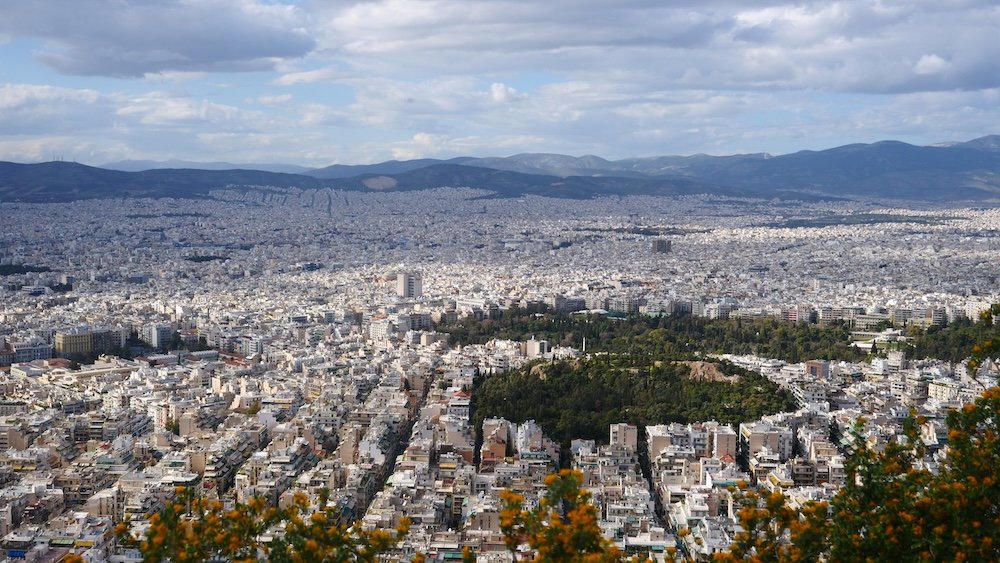
Tips for Visitors
- Take Your Time: There’s no rush to reach the summit. Enjoy the hike, take breaks, and appreciate the natural beauty around you.
- Explore the Area: Beyond the summit, there are other trails and viewpoints to explore on Mount Lycabettus. Take some time to wander and discover new perspectives.
- Stay for the Sunset: If you can, plan your visit to coincide with the sunset. The view of the city bathed in the golden light of the setting sun is truly unforgettable.
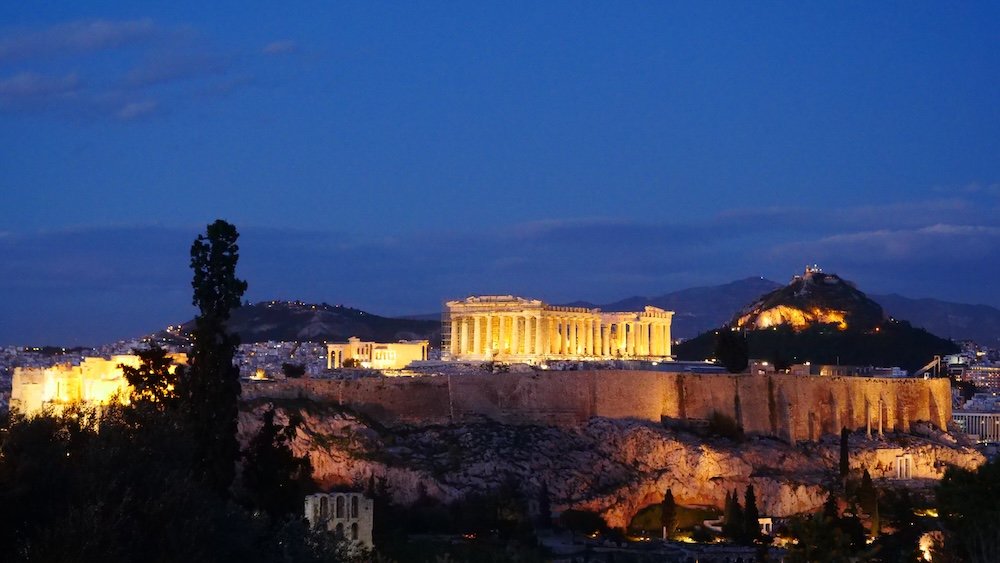
6) Athens Night Views
After sunset we lingered atop Mount Lycabettus for some night views of the city before taking the funicular down to the bottom. Consequently, seeing the Acropolis all lit up at night was a pretty cool sight!
The beauty of Athens at night is captivating. The Acropolis, with its iconic Parthenon, glows majestically atop its hill, visible from almost every corner of the city. The streets of Plaka and Monastiraki come alive with twinkling lights.
Athens at night exudes romance. One of the most epic aspects of Athens’ night views is seeing its iconic landmarks illuminated. The Acropolis, the Temple of Olympian Zeus, and the Odeon of Herodes Atticus look even more impressive under the night sky. The strategic lighting highlights the architectural details and adds a sense of drama and grandeur.
Athens is known for its vibrant nightlife. From cozy tavernas and stylish rooftop bars to lively clubs and music venues, there’s something for everyone. Enjoying the night views while sipping a cocktail at a rooftop bar or dancing the night away in Gazi or Psiri adds an extra layer of fun to your evening.
Tips for Visitors
- Explore Multiple Spots: Don’t limit yourself to just one location. Explore different areas to get varied perspectives of the city.
- Plan Ahead: Some spots, like rooftop bars, can get busy. Consider making reservations to secure a good spot with a view.
- Take Your Time: Athens at night is best enjoyed at a leisurely pace. Take your time to soak in the atmosphere and the beauty of the illuminated city.
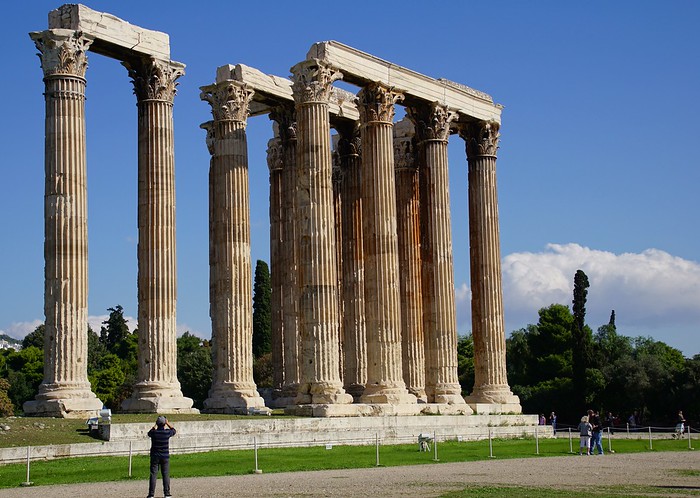
7) Temple of Zeus at Olympia
The Temple of Zeus, which once housed the statue of Zeus, was considered one of the Seven Wonders of the Ancient World.
Once, long forgotten due to flood siltation and landslips, the Temple of Zeus was excavated by a French team in 1829 with fragments taken to the Musée du Louvre.
The Temple of Zeus at Olympia in Athens is one of the largest temples of the ancient world. Its construction began in the 6th century BC and wasn’t completed until the 2nd century AD, under the Roman Emperor Hadrian.
The temple was originally supported by 104 colossal columns, each standing 17 meters high. Today, 15 of these majestic columns remain, giving visitors a sense of the temple’s immense scale and grandeur.
One of the most epic aspects of the Temple of Zeus is its colossal scale. Standing next to these towering columns, you feel dwarfed by their size and can truly appreciate the monumental effort it took to construct such a structure. The temple’s grand scale is a reminder of the power and reverence associated with Zeus, the king of the gods.
Tips for Visitors
- Take Your Time: The Temple of Zeus is best appreciated at a leisurely pace. Take your time to explore the site and absorb the historical and architectural details.
- Join a Guided Tour: A guided tour can provide valuable insights and bring the history and mythology of the temple to life.
- Explore the Surroundings: Don’t miss the chance to explore the nearby attractions, including the Arch of Hadrian and the National Garden.
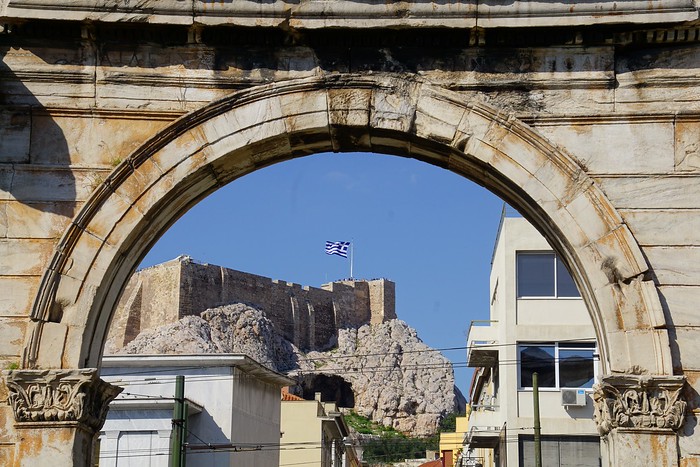
8) Arch of Hadrian
Just a stone throw away from the Temple of Zeus is the Arch of Hadrian. It is believed this monumental gateway was built to celebrate the arrival of the Roman Emperor Hadrian in the city. Moreover, through the arch you get a great vantage point of the Acropolis.
The Arch of Hadrian was constructed in 131 AD to honor the Roman Emperor Hadrian. This monumental gateway marked the transition between old Athens and the new city built under Hadrian’s rule. The inscriptions on the arch reflect this duality: one side reads, “This is Athens, the ancient city of Theseus,” and the other, “This is the city of Hadrian and not of Theseus.”
Standing at 18 meters high, the arch features Corinthian columns and intricate carvings that have withstood the test of time. Its elegant design and impressive scale make it a standout landmark in Athens, providing a striking contrast to the modern buildings around it.
One of the most epic aspects of the Arch of Hadrian is its symbolism as a gateway between two eras. As you pass through the arch, you’re literally walking from ancient Greece into the Roman-influenced part of Athens.
Tips for Visitors
- Explore Nearby: Take time to explore the surrounding area. The Temple of Olympian Zeus and the Acropolis are just a short walk away, offering more historical insights and photo opportunities.
- Visit at Different Times: Consider visiting the arch at different times of the day. The lighting in the morning, afternoon, and evening can create varied and beautiful photographic conditions.
- Learn the History: Read up on the history of the arch before your visit or hire a guide. Understanding its historical context enhances the experience and adds significance to your visit.
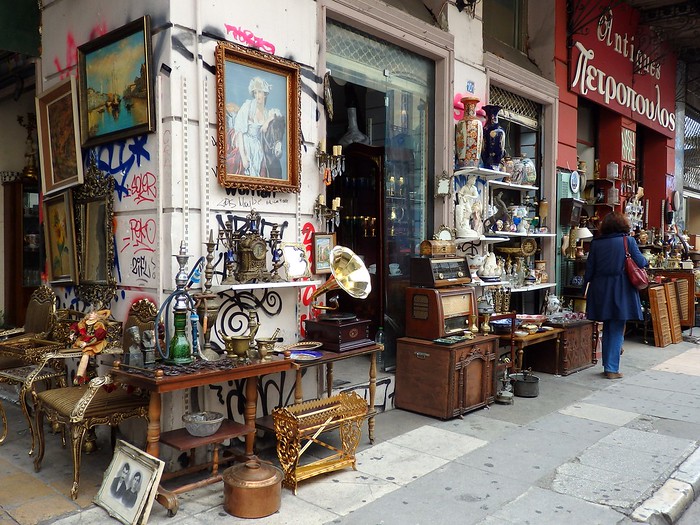
9) Monastiraki Flea Market
When it comes to shopping, there are a few different options. We made our way to Monastiraki, which is one of the principal shopping districts in Athens. Thus, we visited both the Flea Market and the antique shops in the area.
Here, you’ll find a fascinating mix of antique shops, street vendors, and modern stores. From vintage records and antique furniture to handcrafted jewelry and quirky souvenirs, the market is a treasure trove for collectors and casual shoppers alike.
The atmosphere at Monastiraki Flea Market is electric. The lively chatter of vendors and shoppers, the colorful displays, and the aroma of street food all combine to create a sensory feast. It’s a place where you can immerse yourself in the local culture, interact with friendly vendors, and experience the true spirit of Athens.
Whether you’re looking for antiques, fashion, or just a fun outing, the market delivers. Families can enjoy the bustling energy, couples can find unique keepsakes, and solo travelers can lose themselves in the myriad of stalls and shops. It’s a perfect destination for all ages and interests.
Tips for Visitors
- Haggle with Respect: Bargaining is part of the market culture, but always do so respectfully. A friendly approach can go a long way.
- Explore the Side Streets: Don’t stick to the main thoroughfares. Explore the side streets and hidden corners for unique finds and quieter spots.
- Stay Hydrated: Especially during the summer months, it’s important to stay hydrated. Carry a bottle of water and take breaks to enjoy some local refreshments.

10) Greek Street Food
(Greek: σουβλάκι – γύρος)
If you’re looking for a quick bite to eat don’t leave Athens without trying some staple Greek street food. We found a little joint serving up Pita souvlaki and Pita Gyro ordering one of each.
Gyro, meaning to turn, is basically rotisserie-style meat that is cooked on a skewer and then shaved often featuring chicken, pork or lamb stuffed inside a pita.
Moreover, with tzatziki sauce (made with yogurt, garlic and cucumber), loads of onions and tomatoes it makes for filling snack. Only costing 1-2 Euros each, it makes for an affordable alternative to dining for those on a tighter budget.
Greek street food is all about authentic flavors and fresh ingredients. From juicy souvlaki and crispy gyros to sweet loukoumades and flaky spanakopita, each dish tantalizes the tastebuds.
To experience the best Greek street food, head to areas known for their vibrant food scenes. Monastiraki Square, Psiri, and the Central Market are hotspots for delicious street food. Explore the side streets and look for places where locals are eating – it’s often a sign of great food.

Tips for Visitors
- Try a Variety: Don’t stick to just one dish. Sample a variety of foods to fully experience the range of Greek street cuisine.
- Ask for Recommendations: Don’t hesitate to ask vendors or locals for their recommendations. They can point you to the best dishes and stalls.
- Enjoy the Moment: Take your time to savor the flavors and enjoy the atmosphere. Street food is meant to be enjoyed in the moment, so relax and immerse yourself in the experience.

11) Psirri Street Art
(Greek: Ψυρρή ή Ψυρή)
Psirri is known for its lively nightlife, but what caught our attention when visiting by day was the street art! Hence, some of the pieces were quite elaborate, while others were bordering vandalism. But regardless it was a really interesting neighborhood to wander around.
Street art in Psirri is a form of cultural expression. Each mural and piece of graffiti tells a story. It reflects social issues, political messages, and personal sentiments.
The diversity of styles in Psirri’s street art is astounding. From large-scale murals to detailed stencils, and vibrant graffiti to thought-provoking installations, there’s something to catch every eye. The mix of local and international artists ensures a wide range of artistic influences and techniques, making each walk through Psirri a fresh and exciting experience.
One of the most epic aspects of Psirri Street Art is its ever-changing nature. Street art is inherently transient. With new pieces appearing and old ones evolving or disappearing over time. This dynamic quality means that no two visits to Psirri are ever the same. Each trip reveals new artworks and fresh perspectives. Thus, keeping the experience perpetually exciting and unpredictable.
Tips for Visitors
- Stay Curious: Keep your eyes open for art in unexpected places. Street art in Psirri can be found on walls, doors, and even utility boxes.
- Engage with Locals: Don’t hesitate to chat with locals or shop owners. They often have interesting stories and can point you to hidden gems.
- Respect the Art: Remember that street art is a form of expression. Appreciate it respectfully and avoid touching or damaging the pieces.

12) Kerameikos Cemetery
(Greek: Νεκροταφείο Κεραμικού)
Kerameikos Cemetery, the largest and most ancient cemetery in the city, used to be the potter’s quarter which is where the word ceramics comes from.
Kerameikos Cemetery is the final resting place of many notable Athenians from the classical period. As the primary cemetery of ancient Athens, it has witnessed countless significant events and contains graves and monuments that date back to the 12th century BC.
The intricate details on the gravestones and the grandeur of the burial mounds are awe-inspiring. The stele of Hegeso and the reliefs on various tombstones offer a window into the artistic and cultural practices of ancient Athens. The site includes remnants of the ancient city walls, the Dipylon Gate, and the Sacred Way, which was the main route for religious processions.
The nearest metro station is Kerameikos on Line 3, just a short walk from the site. Consider combining your visit with a trip to the nearby Gazi district for a full day of exploration.
Tips for Visitors
- Take Your Time: Allow yourself plenty of time to explore the site and absorb its rich history. The tranquility of Kerameikos is best enjoyed at a leisurely pace.
- Visit the Museum: Don’t miss the Kerameikos Museum, which houses many artifacts and provides context for what you see at the cemetery.
- Respect the Site: Remember that Kerameikos is an ancient burial ground. Respect the monuments and the site’s tranquility by keeping noise to a minimum.

13) Changing of the Guard
We also made time to go watch the changing of the guard in front of the Parliament building on Syntagma Square.
Here, the guards were dressed in their white kilts, red caps, and clogs with pompoms. It was fascinating watching the ceremonial steps be carried out in slow motion.
The Changing of the Guard is a nod to Greece’s rich history and enduring traditions. The Evzones, elite soldiers who guard the Tomb of the Unknown Soldier, perform this ritual in full traditional attire. The elaborate uniforms, featuring kilts (fustanella) and pom-pom shoes (tsarouchia), and the solemnity of the ceremony provide a fascinating glimpse into Greece’s heritage.
The synchronized steps, the ceremonial weapon movements, and the silent communication between guards is a mesmerizing display of discipline and coordination.
One of the best things about the Changing of the Guard is that it’s free to watch. Also, Syntagma Square is conveniently located in the heart of Athens. Moreover, the ceremony takes place every hour on the hour.
Tips for Visitors
- Arrive Early: For the best view, especially during the Sunday ceremony, arrive at least 15-20 minutes early.
- Stay Respectful: Remember that the Changing of the Guard is a solemn ceremony. Stay quiet and respectful during the event.
- Explore the Area: After the ceremony, take some time to explore Syntagma Square and the nearby National Garden, which offers a lovely spot for a stroll.
14) National Garden
(Greek: Εθνικός Κήπος)
The National Garden is located in the heart of Athens directly behind the Greek Parliament building. It is open to the public from sunrise to sunset and it’s a nice spot to decompress if the crowds are starting to get to you.
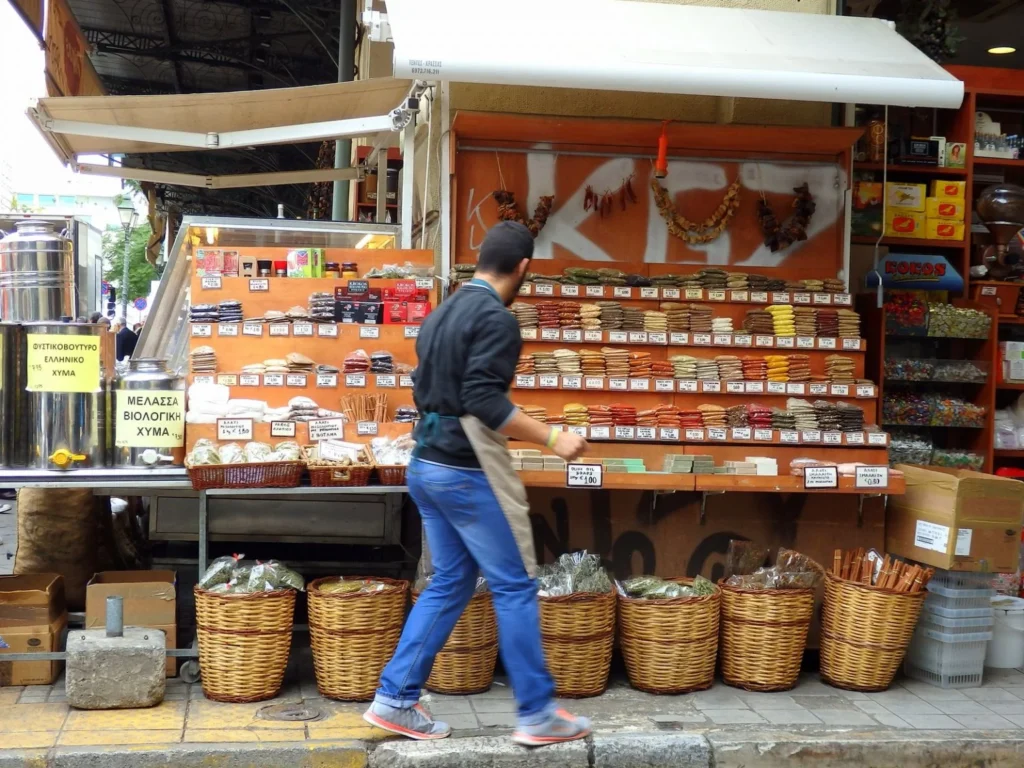
Spanning 38 acres, it’s filled with a diverse array of plant species, from towering palm trees to vibrant flower beds. The park’s design, with its meandering paths and hidden corners, invites leisurely exploration.
Commissioned by Queen Amalia in the 19th century, it was originally the royal garden of the palace, now the Hellenic Parliament. You’ll encounter ancient ruins, statues, and even a small Roman mosaic.
As soon as you step inside, the city noise fades away, replaced by the sounds of chirping birds and rustling leaves. It’s a refreshing and unexpected retreat that showcases the harmonious blend of nature and history.
The National Garden is conveniently located next to Syntagma Square. The nearest metro station is Syntagma, just a short walk from the garden’s entrance.
Tips for Visitors
- Explore the Hidden Corners: Don’t stick to the main paths. Wander through the smaller trails to discover hidden statues, ancient ruins, and serene spots.
- Visit the Zoo and Playground: If you’re with children, make sure to stop by the small zoo and playground. They’re a hit with young visitors.
- Relax at the Café: Take a break at the garden’s café. It’s a lovely spot to enjoy a coffee or a light meal while soaking in the peaceful surroundings.
15) Athens Central Market
Athens Central Market features an overwhelming display of fish and meat and is busiest between 7am and 1pm.
It takes a strong stomach to set foot inside. But as you’ll also find plenty of other items for sale.
Visiting the Athens Central Market provides an authentic glimpse into everyday life in Athens. This is where locals come to shop, socialise, and pick up fresh ingredients. From rare spices and artisanal cheeses to traditional Greek delicacies like olives, feta, and honey, each stall offers something unique.
The Athens Central Market is located on Athinas Street, close to Monastiraki and Omonia squares. It’s easily accessible by metro, with the nearest stations being Monastiraki and Omonia.
Tips for Visitors
- Explore All Sections: The market is divided into different sections, including meat, fish, and produce. Take your time to explore each area for a complete experience.
- Sample the Goods: Don’t be shy about sampling foods. Many vendors offer tastes of their products, and it’s a great way to discover new flavors.
- Engage with Vendors: Chat with the vendors. They are often happy to share stories and tips about their products, enhancing your understanding and enjoyment of Greek cuisine.
16) Agora
(Greek: Ἀγορά Agorá)
The Agora was the central spot in ancient Greek city-states, and it is where people gathered.
Furthermore, it was the heart of political, commercial, administrative, religious and cultural activity in the city.
It was here that Socrates, Plato, and Aristotle once roamed and engaged in intellectual discussions. Visiting this historic site allows you to stand where these great minds once stood, providing a tangible connection to the foundations of Western civilization.
Highlights include the beautifully preserved Temple of Hephaestus, the Stoa of Attalos, and the ruins of various public buildings and altars. This immersive experience allows you to step back in time and truly appreciate the richness of Greek history.
Moreover, the Agora offers stunning views of the Acropolis and the surrounding landscape. These views are particularly breathtaking at sunrise or sunset, when the light casts a golden hue over the ancient stones.
The on-site museum, housed in the reconstructed Stoa of Attalos, showcases artifacts and offers further context to what you see. The nearest metro station is Monastiraki, a short walk from the Agora’s entrance.
Tips for Visitors
- Take Your Time: The Agora is best enjoyed at a leisurely pace. Allow yourself plenty of time to explore the site and absorb its rich history.
- Join a Guided Tour: A guided tour can provide valuable insights and bring the history of the Agora to life. Many tours are available in multiple languages.
- Visit the Museum: Don’t miss the on-site museum. It houses a vast collection of artifacts that provide additional context and depth to your visit.
17) Acropolis Museum
(Greek: Μουσείο Ακρόπολης)
Like the name suggests, the Acropolis Museum is located at the foot of the Acropolis.
And it’s mainly focused on the findings of the archaeological site of the Acropolis. It’s a cool spot to visit if you want to delve deeper into history.
From the iconic Parthenon Marbles to intricate sculptures and everyday objects, the museum’s exhibits provide a comprehensive look at the artistic and cultural achievements of ancient Greece.
Designed by Bernard Tschumi and Michael Photiadis, the building seamlessly blends modern design with the ancient surroundings. Its sleek glass and concrete structure allows natural light to flood the galleries.
The Parthenon Gallery is a highlight of the museum. Located on the top floor, this gallery offers a 360-degree view of the Acropolis while housing the Parthenon Marbles in their original layout.
After exploring the exhibits, you can relax at the museum’s café. Enjoy a coffee or a light meal while soaking in the panoramic scenery. The museum is conveniently located in the heart of Athens, near the Acropolis metro station.
Tips for Visitors
- Join a Guided Tour: Consider joining a guided tour to gain deeper insights into the artifacts and their historical context. The museum offers tours in multiple languages.
- Take Your Time: Allow yourself plenty of time to explore the museum at a leisurely pace. The exhibits are rich in detail, and there’s much to see and learn.
- Visit the Shop: Don’t forget to stop by the museum shop, which offers a wide range of books, souvenirs, and replicas of artifacts. It’s a great place to pick up a memento of your visit.
18) Pláka
(Greek: Πλάκα)
Plaka is an old historical neighborhood located on the eastern slopes of the Acropolis. The place is a bit of a maze with zigzagging streets and a network of staircases that lead up down and around.
Here, the neighbourhood has plenty of charms. And there are also lots of restaurants and cafes if you do start feeling a little peckish.
As you stroll through its narrow alleyways, you’ll encounter neoclassical buildings, Byzantine churches, and ancient ruins. The area is a living museum.
The neighborhood is home to several important sites, including the Tower of the Winds, the Roman Agora, and the Lysicrates Monument. Additionally, Pláka is dotted with small museums, galleries, and theaters.
Pláka is located just below the Acropolis with the nearest metro stations being Acropoli and Monastiraki.
Tips for Visitors
- Explore Beyond the Main Streets: Venture off the main thoroughfares to discover hidden gems, quaint alleys, and less crowded spots.
- Try Local Delicacies: Don’t miss the chance to sample traditional Greek dishes at local tavernas. Ask for recommendations to find the best spots.
- Enjoy the Nightlife: Pláka’s nightlife is vibrant yet relaxed. Enjoy a drink at a local bar or listen to live music at a cozy café.
19) Hadrian’s Library
(Italian: Museo Civico di Storia Naturale di Milano)
Hadrian’s Library was built by the Roman Emperor Hadrian in 132 AD and it used to be his library. Back in its heyday they used to store Papyrus scrolls here. And they also had reading rooms and lecture halls.
The complex was originally designed as a vast courtyard surrounded by columns, with a central building that housed the library’s collection of books and scrolls. The ruins you see today include impressive remnants of the Corinthian columns, marble pavements, and the grand entrance.
The library once contained reading rooms, lecture halls, and even an auditorium where scholars and philosophers would gather to share ideas. Hadrian’s Library is centrally located near Monastiraki Square nearby Monastiraki station.
Tips for Visitors
- Take Your Time: Allow yourself plenty of time to explore the site and absorb its historical significance. The ruins are rich in detail, and there’s much to see and learn.
- Join a Guided Tour: Consider joining a guided tour to gain deeper insights into the history and architecture of Hadrian’s Library. Tours are available in multiple languages.
- Explore Nearby Attractions: Combine your visit with a trip to nearby attractions such as the Roman Agora and Monastiraki Flea Market for a full day of exploration.

20) Greek Cooking Class
Lastly, if you want to take some Greek recipes back home to your kitchen.
Consider taking a cooking class where you’ll learn how to make all of your favorite Greek dishes.
Imagine making your own spanakopita (spinach pie), moussaka, or baklava. The sense of accomplishment that comes from crafting these traditional dishes is incredibly satisfying. Plus, you get to enjoy a delicious meal at the end, knowing you made it yourself.
The communal aspect of the class mirrors the Greek way of dining, where meals are often a shared, joyous occasion. The classes are designed to be engaging and entertaining. This ensures that everyone has a great time while learning new skills.
Athens offers a variety of cooking classes, from small, intimate sessions to larger, more structured classes.
Tips for Visitors
- Arrive Hungry: You’ll be tasting and eating throughout the class, so come with an appetite.
- Be Open to Learning: Whether you’re a novice or an experienced cook, there’s always something new to learn. Embrace the experience with an open mind and a willingness to try new things.
- Enjoy the Process: Don’t rush. Enjoy the process of cooking, learning, and sharing the experience with others. It’s as much about the journey as it is about the final dish.
Athens Travel Video
Athens Photo Essay




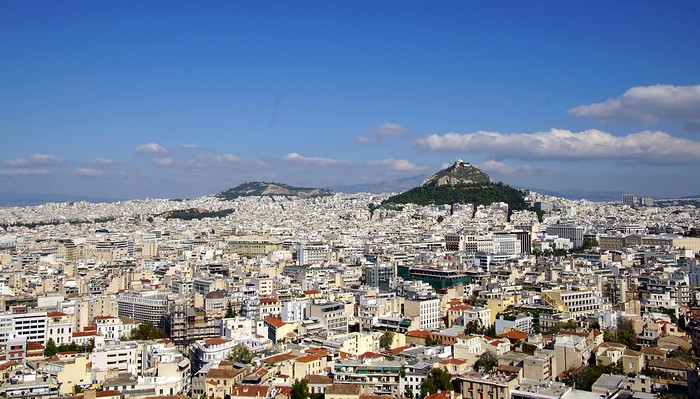

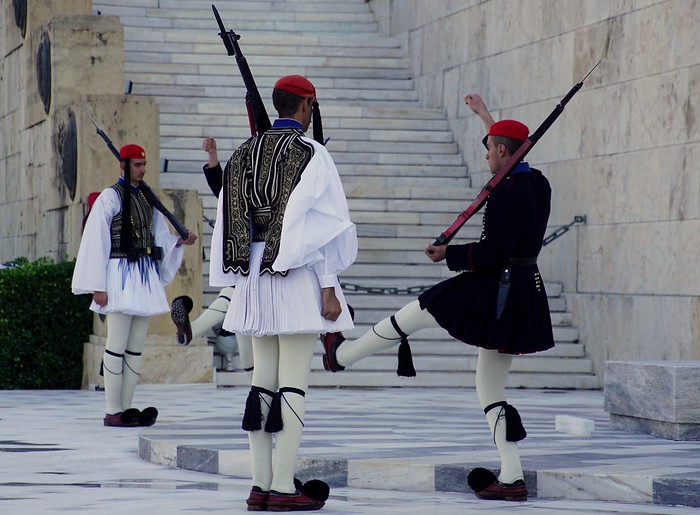
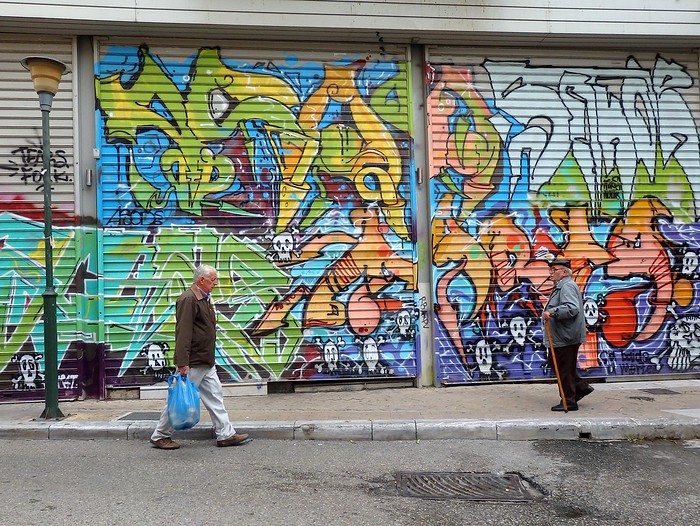

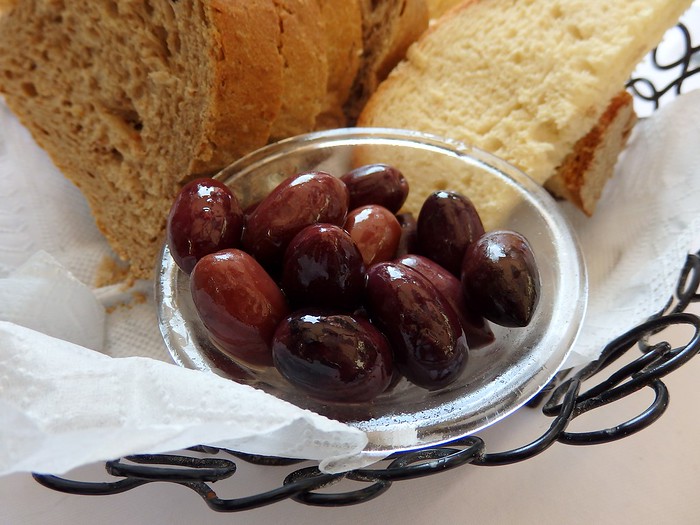


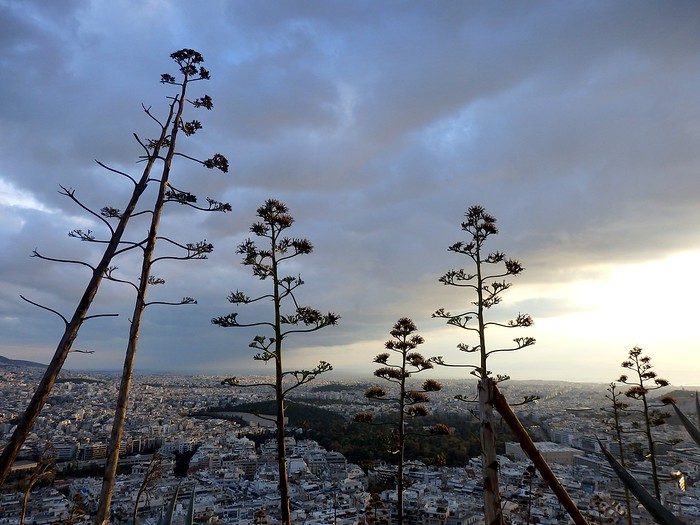
Where to stay in Athens: neighbourhoods that actually make sense
Athens is pretty big. Choosing the right base can save you a lot of hot, uphill walks and sweaty metro rides. Here’s a quick at-a-glance comparison and then we’ll break it down.
| Neighbourhood | Vibe | Best for | Watch out for |
|---|---|---|---|
| Plaka | Old-town, village feel, very pretty | First-timers who want postcard Athens | Touristy restaurants, higher prices |
| Monastiraki | Lively, market streets, central | Short stays, nightlife, metro connections | Can be noisy, a bit gritty around the station |
| Koukaki | Residential but cool, near Acropolis | Couples, foodies, longer stays | Fewer big sights right on the doorstep |
| Psirri | Street art, bars, late nights | Night owls, street photographers | Noisy until late, especially weekends |
| Syntagma | Busy, business + shopping | People who want to be “in the middle of everything” | Traffic, protests from time to time |
| Exarchia | Student, alternative, edgy | Budget travellers, café-hoppers | Graffiti, protests; not everyone’s vibe |
| Piraeus | Port city, practical base | Early ferries, cruise days | Feels more functional than charming |
Plaka: classic “I’m in Athens” energy
If it’s your first time in Athens and you want to step outside and immediately see pastel houses and tavernas with fairy lights, Plaka is hard to beat.
- Easy walks to the Acropolis, Roman Agora, and Anafiotika.
- Lots of small guesthouses, boutique hotels, and rooftop terraces.
- Perfect if you have 2–3 nights and don’t want to figure out the metro right away.
Downside? It’s popular. Expect crowds and higher restaurant prices than in more local areas.
Monastiraki: markets, views, and convenience
Monastiraki is where you stay if you want to hop on the metro to the airport or Piraeus port and still be able to walk everywhere in the centre.
- Direct metro line to the airport and to the port.
- Monastiraki Square, flea market, and plenty of cheap eats.
- Rooftop bars with big views of the Acropolis at night.
It’s busy, a little chaotic, and can be noisy at night, but if you’re only in town for a short stopover it’s incredibly practical.
Koukaki: local but close to everything
Koukaki sits just south of the Acropolis. It feels more like a real neighbourhood and less like an open-air souvenir shop.
- Great base for the Acropolis Museum, Philopappos Hill, and evening strolls along pedestrianised streets.
- Plenty of bakeries, cafés, and modern Greek restaurants.
- Good choice if you’re staying 4+ nights and want a homey feel.
It’s still central, but you’ll use your feet or the metro a bit more than from Plaka/Monastiraki.
Psirri: street art and nightlife
You already saw the murals; staying in Psirri means you’re right in the middle of that creative, slightly wild energy.
- Bars, live music, meze places, and late-night souvlaki.
- Interesting little boutiques and workshops during the day.
- Easy walk to Monastiraki, Plaka, and the Agora.
If you’re sensitive to noise, look for a room facing an inner courtyard or go for another area and just visit Psirri in the evening.
Syntagma, Exarchia, and Piraeus
- Syntagma gives you quick transport links and big-city convenience: metro hub, airport bus, and walking distance to most sights. It’s handy, but expect traffic and crowds.
- Exarchia is more alternative and student-heavy. Cheap food, good coffee, lots of graffiti, sometimes demonstrations. Great for budget travellers comfortable in slightly rough-around-the-edges areas.
- Piraeus works if you’re catching very early ferries or ending a cruise, but for a first taste of Athens, the central neighbourhoods are much more atmospheric.
Getting from the airport and port into the city (without overpaying)
Athens has one main airport (ATH) and several ports. The good news: you’ve got options at every price point.
From Athens Airport (ATH) to the centre
Typical choices:
| Option | Approx. time | Good for | Notes |
|---|---|---|---|
| Metro (Line 3) | 40–45 minutes | Most travellers | Direct to Syntagma and Monastiraki |
| Airport bus | 45–60 minutes | Late-night arrivals, budget | Runs 24/7, several routes |
| Taxi / pre-booked transfer | 30–40 minutes | Groups, lots of luggage | Flat fare structure, more comfortable |
| Car rental | Depends on traffic | Road trip days | Not necessary if you’re only in Athens |
A simple rule:
- Staying near Syntagma or Monastiraki → Metro is usually easiest.
- Arriving very late or with kids + big bags → Taxi or pre-booked transfer is worth the extra cost.
- Heading straight to Piraeus from the airport → Look for the direct airport–Piraeus bus or stay on the metro to change lines.
Reaching the ferry ports
Most travellers use:
- Piraeus – main port for islands like Aegina, Hydra, the Cyclades, Crete.
- Rafina – smaller, good for some Cyclades islands.
- Lavrio – for a handful of routes, including Kea.
Quick logistics:
- From central Athens to Piraeus: hop on the green metro line; it’s the final stop. Allow extra time in summer because the ferries leave right on schedule.
- To Rafina or Lavrio: most convenient is a direct bus or pre-booked transfer. I’d avoid driving there straight after a long-haul flight if you’re jet-lagged.
Getting around Athens once you’re in
You’ll walk a lot in Athens. But you don’t have to walk everywhere.
Walking, hills, and heat
Most of the big sights cluster around the Acropolis: Parthenon, Plaka, Monastiraki, Agora, Temple of Olympian Zeus, and the museums.
- Distances are short, but:
- Streets can be uneven.
- Summer heat is serious.
- There are hills. Lots of them.
Plan your steep climbs (Acropolis, Philopappos, Lycabettus) for early morning or late afternoon and keep your midday for museums, siestas, or long lunches.
Metro, tram, and buses
Athens’ metro is straightforward and clean, with clear English signage.
- Metro is ideal for:
- Airport connections.
- Reaching Piraeus port.
- Getting between Syntagma, Monastiraki, Omonia, and Koukaki.
The tram is handy if you’re staying out towards the coast and want to combine a bit of city time with beach time. Buses fill in the gaps, but if you’re only in town for a few days you can easily do 90% of your moving around on foot and metro.
For tickets, think in terms of time windows rather than individual rides. You’ll usually find:
- Single tickets valid for multiple transfers within a set time.
- Day passes if you’re planning to hop around a lot.
- Special airport tickets that cost more but cover the longer ride.
Taxis and ride-hailing
Taxis are plentiful and relatively affordable compared to many Western European capitals.
- Always make sure the meter is turned on.
- Have your destination written down; smaller streets can be tricky.
- For peace of mind, many travellers like using local ride-hailing apps, which give you an upfront fare estimate.
Making sense of Acropolis & ancient site tickets
There are a few ways to structure your “ancient Athens” days, and the ticket options can feel confusing. Here’s the simplified version.
| Ticket type | Includes | Best for | Pros | Cons |
|---|---|---|---|---|
| Single-site Acropolis ticket | Acropolis hill + monuments | Short visits, tight budgets | Cheaper if you’re only doing the Acropolis | Doesn’t cover Agora, Kerameikos, etc. |
| Multi-site combo ticket | Acropolis + several sites (often Agora, Hadrian’s Library, Kerameikos, etc.) | History lovers staying 2–3 days | Great value if you’ll see multiple ruins | You need to actually use it to get value |
| Guided tour with ticket | Varies by company | Travellers who want context | Skip-the-line access, storytelling, no logistics stress | More expensive, fixed schedule |
A simple strategy that works for most:
- Use one big “ancient sites” day where you tackle the Acropolis in the early morning, then move on to the Agora and another site or two.
- Use your remaining city time for neighbourhoods, food, and hills with views (Lycabettus, Philopappos).
How many days do you really need in Athens?
If you love history and food, you can easily fill a week. But even a short stop is worth it. Here are realistic plans you can copy and tweak.
1 full day in Athens: “greatest hits”
- Morning
- Early Acropolis visit (as soon as gates open if you can).
- Walk down through the Theatre of Dionysus towards the Acropolis Museum and do a focused visit there.
- Afternoon
- Lunch in Plaka or Koukaki.
- Wander the Roman Agora and Monastiraki.
- Coffee or cold drink with a view.
- Evening
- Head up Mount Lycabettus for sunset.
- Dinner in Kolonaki, Psirri, or back in Plaka.
You won’t see everything, but you’ll hit the main icons and get a feel for the city.
2–3 days in Athens: deeper dive
Day 1 is the same as above. Then:
- Day 2
- Ancient Agora, Temple of Hephaestus, and Hadrian’s Library.
- Lunch near Monastiraki or the Central Market.
- Explore Psirri’s street art and cafés.
- Evening in Gazi or Psirri for nightlife, or a more relaxed taverna dinner in Koukaki.
- Day 3
- National Archaeological Museum or Benaki Museum in the morning.
- National Garden and Changing of the Guard at Syntagma.
- Late-afternoon stroll through Anafiotika and quiet backstreets of Plaka.
- Dinner at a traditional taverna with live music if you can find one.
4+ days in Athens: mix in a day trip
Once you hit four nights, you can add:
- A day trip to Aegina (easy ferry from Piraeus, great if you want a quick island fix).
- Or Kutná Hora style equivalent for Greece – in this case, Cape Sounion & the Temple of Poseidon for sunset.
- Or a full-day island cruise if you don’t yet have longer island time planned.
What it actually costs: budgeting for Athens
Everyone travels differently. Here’s a rough daily framework (per person) excluding flights and big shopping splurges.
| Style | Approx. daily budget | Sleep | Eat | Experiences |
|---|---|---|---|---|
| Shoestring | €45–70 | Hostel bed or very basic room | Street food, bakery lunches, supermarket snacks | Pick 1–2 paid sights per day, walk everywhere |
| Mid-range | €80–140 | Comfortable hotel or apartment | Mix of street food and sit-down tavernas | Multiple paid sights, maybe a guided tour |
| Splash-out | €160+ | Boutique or luxury hotel with view | Long dinners with wine, rooftop cocktails | Private tours, transfers, special experiences |
Quick money-saving tips:
- Eat lunch at sit-down restaurants and go more casual for dinner. Lunch deals are often better.
- Use bakeries for cheap, delicious breakfasts: cheese pies, spinach pies, koulouri.
- Combine several ancient sites on the combo ticket rather than buying individual entries.
- Tap water is generally drinkable in Athens, so refilling a bottle saves small but steady amounts.
When to visit Athens (and what to expect each season)
You can visit Athens year-round. Yet your experience will change a lot depending on when you go.
Spring (March–May)
- Mild temperatures, blooming flowers, and longer days.
- Great for sightseeing without melting.
- Easter can be a special time to visit, but also busier and with some schedule changes.
Summer (June–August)
- Hot. Really hot, especially July–August.
- Longer opening hours, plenty of events and rooftop bars in full swing.
- Plan early-morning and late-afternoon sightseeing, and put museums and naps in the middle of the day.
Autumn (September–November)
- Still warm in September, pleasantly cooler by October.
- Sea is still swimmable early in the season if you’re combining Athens with island time.
- A sweet spot for fewer crowds and more comfortable temperatures.
Winter (December–February)
- Cooler and sometimes rainy, but rarely freezing.
- Fewer tourists, lower prices, and a more local feel.
- Some sites have shorter opening hours, but you’ll have space to breathe.
If your dates are flexible, late April–early June and late September–October hit the best balance of weather and crowds.
Common Athens mistakes (and how to avoid them)
A few simple tweaks can make your time in Athens smoother.
Doing the Acropolis in the midday heat
Climbing that hill at 1 p.m. in August is… character building. But not fun.
- Aim for opening time or the last entry of the day.
- Bring water, a hat, and sunscreen.
- Take breaks in whatever shade you can find.
Underestimating walking distances and hills
On a map it all looks close. On the ground, it’s cobblestones, steps, and slopes.
- Wear decent shoes, not flimsy sandals.
- Group sights by area rather than ping-ponging across town.
- Give yourself buffer time between “must-see” things.
Ignoring local eating rhythms
Restaurants don’t really get going for dinner until later.
- If you want a quieter meal, go early by local standards.
- If you want atmosphere, aim for 9 p.m. or later.
- Avoid places with aggressively shouted tourist menus; you’ll generally eat better a street or two away.
Forgetting about strikes and demonstrations
Athens sometimes has transport strikes or demonstrations around Syntagma.
- If you have an early ferry or flight, double-check transport the day before.
- Give yourself extra time getting to the airport/port, especially if there are news of disruptions.
- If you stumble upon a protest, keep your distance and loop around; they’re usually peaceful but dense crowds aren’t fun.
Treating Athens as “just a stopover”
It’s tempting to rush through Athens on the way to the islands. But the city really rewards an extra night or two.
- Slow down, add one more evening, and let yourself wander neighbourhoods with no checklist.
- Sit in a café with a cold coffee, watch everyday life, and let Athens grow on you a bit.
That’s where the city really shines.
Key questions about visiting Athens, Greece: practical answers and local tips
How many days do you really need in Athens for a first visit?
Honestly, three full days is the sweet spot for most people. With one day you can rush through the Acropolis, the museum, and a quick wander around Plaka and Monastiraki, but it will feel like a sampler platter. Two to three days lets you mix ruins with neighbourhoods, hills with views, markets, and lazy taverna lunches without sprinting everywhere. If you have four or more days, you can start adding a day trip to Aegina, Delphi, or Cape Sounion and still have time to just sit in a café and watch Athens go by.
What is the best time of year to visit Athens and avoid extreme heat and crowds?
It depends. Spring and autumn are the jackpot for most travellers. From late April to early June and again from late September through October, you usually get warm but walkable temperatures, long enough days, and fewer cruise groups clogging the paths up to the Acropolis. July and August can be brutally hot, so you need early starts, big hats, and long museum breaks in the middle of the day. Winter is cooler and sometimes rainy, but if you do not mind putting on a light jacket you get cheaper rooms, shorter queues, and a much more local feel.
Is Athens safe for tourists and which areas feel sketchy at night?
Generally, yes. Athens is a busy, lived-in capital, and most visitors never run into serious problems. The main things to watch for are pickpockets on the metro, especially around Syntagma, Monastiraki, and Omonia, plus the usual bag-snatching risk in crowded squares. At night, some streets around Omonia and parts of Exarchia can feel a bit rough around the edges, so I usually tell people to stick to well-lit main roads and avoid wandering dark backstreets after midnight. As always, keep valuables zipped away, use a money belt or cross-body bag, and trust your instincts; if a place feels off, move on.
Can you drink the tap water in Athens or should you stick to bottled?
Yes. Tap water in Athens is considered safe to drink, so you can absolutely refill your bottle at the hotel or apartment and not worry about brushing your teeth with it. Many Athenians still buy bottled water out of habit or taste preference, but there is no requirement to do that for safety reasons. A nice bonus is that there is a legal price cap on small bottles of water, so a 500 ml bottle is very cheap if you grab one from a kiosk or supermarket when you are out exploring.
Do you need to buy Acropolis tickets in advance and how do the time slots work?
Absolutely. In high season, pre-booking your Acropolis ticket makes a huge difference because it locks in a specific entry window and means you are not standing in a long ticket line under full sun. When you buy online from the official system or a reputable partner, you normally choose a date and time band and need to enter during that window, then you can stay on the hill for a reasonable amount of time once inside. In shoulder and low season you can sometimes get away with buying at the gate, but I still like booking at least the Acropolis ahead of time so I can plan the rest of the day around it. Whatever you do, aim for first thing in the morning or late afternoon to avoid both heat and the biggest crowds.
Is the Acropolis combo ticket worth it, and which ruins should you prioritise if you are short on time?
Usually yes, if you love history. There is a multi-site ticket that covers the Acropolis plus several other major ruins, and it is valid for multiple days, so you can spread the sightseeing out a bit instead of trying to cram everything into one marathon. Current prices sit in the rough range of under ten euros for the cheapest single-site tickets and around thirty euros for the multi-site pass that covers a handful of Athens’ big hitters, which is excellent value if you are ticking off places like the Agora, Kerameikos, and Hadrian’s Library as well. The Cloud Keys If you are tight on time, I would prioritise the Acropolis, the Ancient Agora with the Temple of Hephaestus, and one “secondary” site that appeals to you most, such as Kerameikos Cemetery for atmosphere or the Temple of Olympian Zeus for sheer scale.
Do you really need a guided tour for the Acropolis and other ancient sites?
Nope. You can absolutely visit the Acropolis and other ruins on your own and still have a great time, especially if you read up a little beforehand or download an audio guide app. That said, a good guide really does bring the stones to life, connects myths with what you are seeing, and helps you dodge some of the worst bottlenecks. My compromise suggestion is to do one guided tour that covers the Acropolis and maybe the Agora, then explore the rest of the city independently once you have the historical context in your head. If your budget is tight, even a self-guided walking tour routed through Plaka and around the base of the Acropolis will help you see things with new eyes.
Is Athens a good city to visit with kids or a stroller?
Yes. Athens can be surprisingly fun with kids, as long as you pace things and do not try to do three hill climbs in one day. Many of the big sights have at least partial step-free access, and the new Acropolis Museum in particular is very stroller-friendly with lifts, ramps, and space to move. The challenges are the heat in summer and the occasional uneven pavements in older neighbourhoods like Plaka and Psirri, so a sturdy stroller and plenty of shade breaks are your friends. Mix in kid-friendly stops like the National Garden, the Central Market, ice cream breaks, and short ferry rides to nearby islands for a well-balanced trip.
What is the easiest way to get from Athens Airport to the city centre or Piraeus port?
For most visitors, the airport metro line is the cleanest and simplest option because it runs straight into the centre and stops at Syntagma and Monastiraki, which are handy for many hotels. There is also an express airport bus that runs 24 hours a day and is slightly cheaper, which is great if your flight lands around the time the metro is closing for the night. Taxis and pre-booked transfers cost more but make sense if you are a family with luggage, arriving late, or just want to be dropped at your door with zero navigation stress. From central Athens to Piraeus, the green metro line is the classic way to reach the ferry terminals, and I always tell people to build in extra time in summer because those ferries do not wait.
Do you need a rental car in Athens or is public transport enough?
In almost all cases, you do not need a car in Athens and it can actually be a hassle. Traffic is heavy, street parking is tight, and a lot of the most interesting streets are pedestrian-only or so narrow that you would not want to be driving them anyway. Between walking, the metro, the tram out to the coast, and relatively affordable taxis, you can reach pretty much everything mentioned in the guide without getting behind the wheel. If you are heading out to the Peloponnese, Delphi, or other inland areas, then renting a car for those specific days works well, but return it when you come back into the city.
How expensive is Athens and how much should I budget per day?
Compared to many Western European capitals, Athens is still on the friendlier side for the wallet, especially if you lean into street food, bakeries, and simple tavernas. At the bare-bones end, a patient shoestring traveller can get by on roughly forty-five to seventy euros a day by choosing hostels or very basic rooms, eating gyros and bakery pies, and picking just one or two paid sights per day. A comfortable mid-range budget sits closer to eighty to one hundred forty euros with a decent apartment or hotel, a mix of street food and sit-down dinners, and a couple of paid sites or a small-group tour most days. If you love rooftop cocktails, boutique hotels with Acropolis views, and private tours, it is easy to spend one hundred sixty euros or more per day.
What should you wear for the Acropolis and churches in Athens?
Comfort first. For the Acropolis and other ruins, think breathable clothes, a hat, good walking shoes or sandals with grip, and layers if you are out from early morning into the evening. There is no strict dress code for archaeological sites, but you will be climbing uneven paths and standing in the sun, so this is not the time for flimsy flip-flops. Churches and monasteries are where modesty matters more; shoulders should be covered, shorts and skirts should ideally come to the knee, and hats come off inside. A light scarf in your day pack is an easy way to adapt if you decide to pop into a church on the fly.
What are the best day trips from Athens if I have extra time?
Delphi is the classic history day trip, with dramatic mountain scenery and temple ruins that feel like they have been dropped on the edge of the world. If you want sea air and island vibes without committing to a longer itinerary, Aegina is an easy hop from Piraeus, with pistachios, beaches, and the Temple of Aphaia. Cape Sounion and the Temple of Poseidon are perfect for a shorter half-day that ends with sunset over the sea. If you have already ticked those off, look into Nafplio, Corinth, or even a one-day island cruise that strings a few Saronic Gulf islands together.
What common scams or tourist traps should I watch for in Athens?
Most of the time Athens feels straightforward, but there are a few patterns to keep on your radar. In very touristy streets you will sometimes get “friendly” people trying to push you into their restaurant with promises that are not reflected in the bill, so I like to walk a block or two away from the main drag before sitting down. Around big squares and on busy pedestrian streets, watch out for people trying to hand you “free” bracelets, flowers, or small trinkets and then demanding payment once they are on your wrist or table. As in many cities, only use official taxis, keep an eye on the meter, and avoid anyone trying to steer you to a particular bar or club with vague discount promises.
Is it worth staying near the port in Piraeus before or after an island trip?
Sometimes. If you have a very early ferry, a late-night arrival back from the islands, or you are travelling with kids and just want the logistics to be simple, sleeping near the port can make sense. You will not get the same historic atmosphere as staying in Plaka or Monastiraki, but you will gain the peace of mind of being a short walk or quick taxi ride from your ship. For most first-time Athens trips, though, I usually recommend basing yourself in the central neighbourhoods and just taking the metro or a taxi down to Piraeus on ferry days so you get the full Athens experience.
Can you see Athens properly on a cruise stop with only one day in port?
Not completely, but you can still have a fantastic taste. With a single cruise day you will want to be efficient: come straight into town from Piraeus, do the Acropolis as early as you can, then spend the rest of the day between the Acropolis Museum, Plaka, Monastiraki, and maybe a quick view stop like Areopagus Hill. Pre-booking tickets and having a rough walking route mapped out will save you a lot of faffing with maps and queues. If your ship overnights in Piraeus, use the second evening for a proper taverna dinner and a nighttime view of the Acropolis lit up, which is when the city really works its magic.
Practical details around tap water, tipping, and typical ticket ranges were cross-checked against Athens’ official visitor information and recent local transport and sightseeing guides at the time of writing.
Our Athens Trip: Final Thoughts
With Greece receiving a lot of bad press in the media lately it has scared off a lot of visitors which is a total shame.
What we found is that locals went out of their way to be helpful and we had instances where we ate meals at a restaurant where many extras (appetizers, drinks and desserts) were brought to our table free of charge.
With a mix of antiquity and urban Athens is one of my favorite cities in all of Europe and I highly recommend you visit NOW.
If you have any more suggestions of activities that travelers shouldn’t miss, feel free to share those in the comments below.

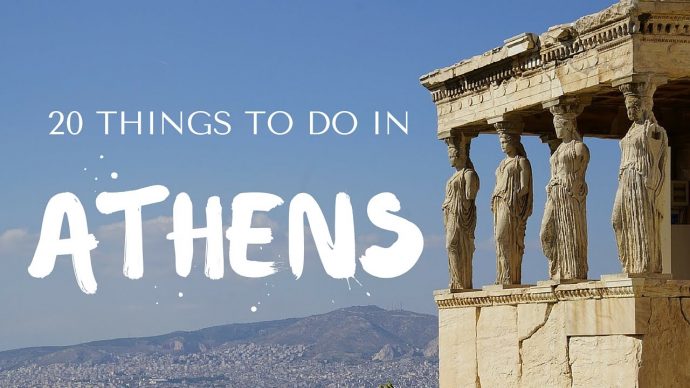


Thanks for sharing! I am going to Athens in three weeks. I want to book a guided Athens tour and visit the must see sights of the city, as I will stay only for 4 days. I found this https://www.discovergreekculture.com/tours/classical-athens-classically-greek/ It seems to be quite interesting. I ‘ll keep looking for a few more days before I make my decision.
Hey Samuel, what were the dates you guys traveled to Athens?
I have hoped to visit Greece forever and this coming year is the one to make that dream come true! It is a big birthday for me (I’m not telling which one. LOL) and this is a dream trip.
We are taking the kids and I’m already researching for the travel guide I’ll write for the kids at their level. Your post has some new things to me to add to the list of things I want to see, research, and write about. Fried cheese (How do you even do that without it melting??) and I can’t help but chuckle at the guards standing at attention. The one on the far left seems to be nodding off. LOL!
Great post with really interesting things on a wonderful city for exploring!
Congratulations on the report, Greece is indeed a fascinating country.
Wonderful post, i have always been interested in visiting places with a great history. Great video, looking forward to visit this place. Thanks for sharing 🙂
I get to Athens next week. Bookmarking this! I expect to read it many times during the month I’m there. Happy travels!
If you are into sports and you like Olympic Games (I don’t!) Panathinaic Stadium is easy to visit as it is located in the center of Athens.
A trip to Greece has been something I’ve had my eye on for years. This is a great place and includes some options I didn’t know about.
My abiding memories of Athens are a bus station where it was impossible to read destinations and my friend who was too lazy to visit the Acropolis. I had a great time!
I really love the video thanks for the wonderful post
Greece is at the top of our list. It looks absolutely AMAZING! Can’t wait to get there!
I absolutely loved the video. Thanks for the inspiration!
Thank you for watching!
If you visit Athens you can’t miss Vouliagmenis’s Lake , beautiful unusual places !!!
Thanks for the suggestion!
Hi! We just got back from a couple of weeks in Greece too, fabulous place for history, we went south, Sparta, Olympia, Corinth, Mycenae. The Temple of Zeus at Olympia is the 7 wonders one, not the Athens Zeus temple, you may wanna fix that! But the Athens one is stunning too. We really liked Athens, fabulous city.
Oh, thanks for letting us know about that!
Hi, Samuel! Nice list of all *the* places of Athens. I was there for the first time a year ago and enjoyed it a lot. One of the most interesting independent “tours” that we took was exploring the incredible variety of street art in Athens. Absolutely amazing! How did you like it when you were there?
Thank you! Indeed, we found the street art to be one of the coolest features of the city. It gave it a gritty yet artsy vibe.
Did you get a chance to go to the Greek Islands also? Athens is awesome, but the real treasure in Greece is going island hoppings. Your photos are gorgeous by the way!
http://www.worldincolortours.com
No, unfortunately not on this trip!
After my next week trip to meditterean, i’m going Athens. Really nice to see this post. Definitely one of my favorite for the list.
I’m from Marrakech and thanks to your awesome blog I’m travelling in Athens with this article 😀
Thanks !
Damien from http://riad-alma-marrakech.com/
Great list, guys! I’m a massive fan of Athens and think you’ve covered it brilliantly.
Cheers!
Great photos. Athens is near the top of my bucket list. I love the ancient history. Interesting read. Thanks.
Plaka is a great little area to have drinks and relax in while admiring the Acropolis from below. My only advice is to be aware of your surroundings here as my friend had her purse stolen right in front of us when we were distracted for only a few seconds or so. It was an unfortunate experience, but a sober reminder that petty crime can still exist even in the safest of cities, like Athens.
I loved and enjoyed the couple of days I spent in Athens last year. I got to experience almost all of the items you listed here. You missed the open-aired theatre though. It’s only open in the Summer, I think.
I can’t wait to someday visit Athens. It’s my next trip idea but I didn’t know about all these attractions before. I was thinking just beach side and a few old ruins but now I got a better picture so thanks for this share!
thanks for the blog. it was very informative and the pictures are captured beautifully. Greece is definitely on my bucket list now. the food looks attractive too. love the scenic view of Greece. keep up the good work.
Fantastic list, I love Athens, there’s so many wonderful attractions and cool neighborhoods to wander and just explore. It’s a nice mix of old and new and yes the food is amazing too!
This is a great list of things to do. The history and food in Athens is well known but I didn’t know about the art scene, and that flea market sounds awesome.
We’re not usually big city people, but we loved our time in Athens. If I had to recommend something to people, it would be the bike tour of the city we did with EcoAthens. It was 90% downhill and we got to see sides of the city we’d never have explored otherwise.
Thanks. This was really informative. Greece is on my bucket list for quiet sometime, but getting delayed for some reasons. This will prove really handy when we plan our Europe trip mostly during next summer